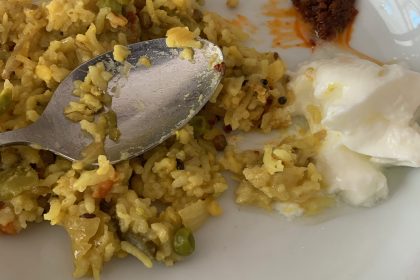Khichdi is a simple, beautifully nutritious and sattvic meal. In Ayurveda there are three universal Gunas (qualities) which influence all of life, and are present in everything, including our bodies and minds. Sattva is pure essence, action and spirituality. Rajas is movement and drive, and Tamas is darkness, and apathy. Foods that are sattvic are fresh, wholesome, pure, unadulterated, and in their natural state. Think of grains, pulses, fruits, vegetables, nuts, seeds, milk, ghee, and butter. These foods provide all the nutrients we require for a healthy mind, body and spirit.

What is khichdi?
Khichdi consists of basmati rice, which is the best rice in Ayurveda, as it’s both sweet and pure, and mung beans, which are incredibly nutritious, and one of the most easily digested foods around. In India, babies are given simple khichdi as their first solid food, and it is fed to elderly people who have lost their muscle mass, strength, and perhaps lack energy. It is soft and unctuous, so there is no concern about not being able to chew it, and it fills the whole system with goodness and vitality.
It is said that khichdi impressed the British Raj so much that they brought the idea back to the UK with them, adapting it to suit their palate. The lack of availability of mung beans here at the time meant that they substituted them with boiled eggs and fish, and this became the dish we call kedgeree in the West. I do love how so much of the food we all eat has been influenced by different cultures.
I was brought up eating khichdi regularly, and still remember eating it as a teenager with toasted papad (poppadoms) and homemade pickle, as well as homemade yogurt. Delicious! When my siblings and I were very young, my mother fed us the simple version below, adding the milk to help soften and mash the grains for easier digestion. I also fed it to my children when they were babies, knowing that it was the purest, most nourishing food I could offer them. To this day, I see it as the food of unconditional love; love that is passed on from you, to those you feed. Food is medicine, after all.
Most of my clients know my love of khichdi (which has been named kitchari in the West, and you might be more familiar with this word), because it is always part of the bespoke health programmes I devise fo them, and I do rather labour the point about the benefits of eating it regularly. It is also the perfect light food to eat when you need to support and heal your digestive tract and other organs, such as during the transition from winter to spring, or if you are feeling a bit under the weather. There are lots of variations too, with the simplest version being a comforting and healing meal for anyone.
For 2-4 servings of simple khichdi:
1 cup basmati rice
1/2 cup split mung beans
A good pinch turmeric powder
2 tsp ghee
Whole milk (optional)
Salt to taste (omit for babies)
Method:
Wash the rice and mung beans well in warm water a few times. Soak in a saucepan for a least an hour, or better still overnight. Drain, and add three cups fresh warm water, a pinch of salt, and the turmeric.
Heat on a medium setting, and once boiling, turn down to low, put a lid on, leaving a small gap for the steam to escape, and cook for 10-12 minutes, until all the water has evaporated.
Serve with the ghee placed on top, and a splash of warm milk, mashing the rice and mung beans a little if you are feeding it to babies or small children.
A vegetable version:
Rice and mung beans as above
A handful of fresh or frozen peas
A small carrot, diced small
Half an onion, finely chopped
A tsp cumin seeds
1/2 tsp mustard seeds
Two cloves
1/2 inch piece of cinnamon
A pinch asafoetida
1/2 tsp ground turmeric
1/4 tsp each of ground cumin and coriander
1/4 tsp chilli powder
2 tbsp organic cold pressed olive oil
2 tsp ghee
Salt to taste
Fresh coriander leaves to serve
Method:
Wash and soak the rice and mung beans as above, and set aside. Heat the oil in a medium saucepan. Add the mustard seeds. Once they fizzle, add the cumin seeds. After a minute, add the onion, and fry it for a couple of minutes to slightly brown it, before adding the cloves, cinnamon, asafoetida. Next throw in the carrots and peas. Stir well before adding the remaining spice powders and salt. Mix everything together thoroughly, and put a lid on. Cook on a low heat for 5-10 minutes, until the vegetables are soft. Now drain the rice and mung beans, and add them to the vegetables. Mix everything well for a few minutes, so the rice and mung beans are incorporated into the vegetables. Add 3 cups of hot water. Cook as above, and add the ghee and coriander leaves before serving.
